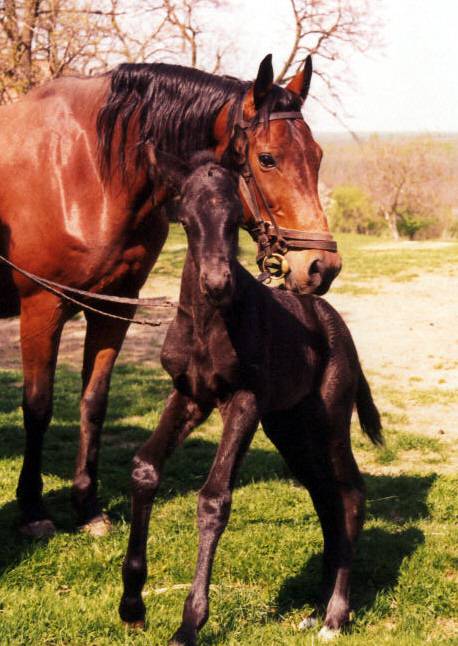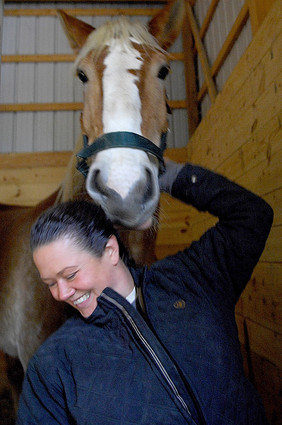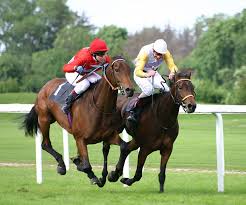As a child, horse slaughter was simply a fact. Now, it's almost a necessity. I don't agree with slaughtering horses, nor do I want any horse to end up at a slaughterhouse, but our society produces far too many unwanted horses.
I receive emails on a weekly basis from several different horse industry and horse welfare news streams. Every time I read one of these legislative "updates", I wonder: When is horse slaughter legislation going to start with the cause of unwanted horses?
Though anti horse slaughter groups have successfully shut down horse slaughterhouses in America, horse breeding has only increased. If horses at auction don't wind up at slaughter, where are all the "unwanted" horses going to go? As with the millions of unwanted dogs and cats who are euthanased every year, it would be nice if we could say unwanted horses are "humanely destroyed." But, horses are just not that easy to put down. Besides being big, difficult to transport, to house, and to feed, horses cost several hundred dollars to put down. For "humane" treatment, horses need not only feed, water, and vaccinations, but also farrier care and often special nutritional, veterinary, and stabling.
When is horse slaughter legislation going to start with the cause of unwanted horses?
Horses end up at auction if they can't be sold privately, can't be cared for, or are (simply) unwanted. If a horse owner sends an "unwanted" horse to auction and the horse doesn't sell, what happens to the horse? If the previous owner can't or won't care for the horse, who will?
It's the same with the overpopulation of dogs and cats. It's better to have a humane society take an unwanted pet and euthanize it than have a pet return to a home where it isn't wanted or cannot be cared for. But again, horses are extremely difficult and expensive to care for. Some say re-homing unwanted horses is not a big deal since the total number of American horses slaughtered per year "only" equals about 1% of the total American horse population. Based on current horse populations (about 9 million in the US), 90,000 "homeless" horses is still a lot of horses. With hay prices up, gas prices up, and affordable land becoming more scarce, most horse people in any part of the country will tell you; "you can't even give 'em away these days."
Some anti-slaughter activists like to claim horse "kill buyers" are outbidding nice families in search of a pet. Really? If a "nice family" is only willing to spend $100, maybe a $150 on a horse, will they be willing to spent another $150 on vaccines once the vet comes out? What about hoof care every six weeks? Hay, grain, shavings? Proper fencing? Does the nice family have money set aside for emergency transport and thousands of dollars worth of colic surgery? Kill buyers, yes, may be out bidding families (occasionally), but this does not mean the family has means to care for the long term health of the horse.
To minimize horse slaughter and unwanted horses, we need a better plan.
Currently, there are no horse slaughterhouses operating in the United States. Despite anti-slaughter group efforts, American horse slaughterhouses have been successfully shut down, but now horses are just sent over the border to Mexico and Canada where the treatment and killing of animals is even less humane than under American standards.
In many ways, the U.S. slaughter ban has already hurt horse welfare.
For reference, American slaughterhouses used retractable pneumatic bolts to render horses unconscious (in theory) before slitting their throats. However, in Mexico, it's common practice to stab horses in the back repeatedly until their spinal cord is severed.
In many ways, the U.S. horse slaughter ban has already hurt horse welfare. Now, anti-slaughter groups are attempting to ban horses exported for slaughter altogether. Despite the fact this new law could be easily circumvented by horse "kill dealers" simply labeling horses transported across the border as "for riding" instead of "for slaughter", we need to first think about minimizing the unwanted horse population before tackling the issue of horse slaughter.
Lets look at some facts:
- According to the USDA, 45,000 horses went to slaughter in Mexico in 2007, and another 26,000 went to Canada (total, 71,000+).
- According to the Jockey Club, 56,000 Thoroughbred mares were bred in 2007.
- According to the Thoroughbred Times, Thoroughbred race horses averaged 25 starts per life in 1950; by 1994, the average Thoroughbred ran just 14 races.
What does this mean? More Thoroughbreds running less races equals more waste. Due to over breeding of the Thoroughbred, not only does the Thoroughbred Times conclude Thoroughbred races horses are less sound than 60 years ago , but also, they are less used.
Moreover, why have we not had a Triple Crown winner in Thoroughbred horse racing since Affirmed in 1978? Could it be that the only requirements for breeding a Thoroughbred horse are a papered mare and money for a stud fee?
I imagine, even in 1978, horse breeding and racing wasn't an incredibly easy or cheap "hobby". Then, not every backyard horse owner could afford a.) a papered Thoroughbred mare, or b.) a 500 mile haul to the stallion. Today, cheap, seedy racetracks are numerous and vastly outnumber the celebrity packed racing events profiled on T.V. It is perceived as "easy" now for anyone to think they can breed the next Kentucky Derby winner. For $250, someone can pick up a lame and unproven (and possibly even unraced) Thoroughbred mare and breed her to an equally lame or unproven Thoroughbred stallion for as little as $300. Boom! For less than a beater car, you too can own the next derby champ!
Wrong.
Of course, many Thoroughbreds going for meat are actually well bred, expensive horses. Some may have stud fees of $500,000 or more. By and large, racehorses don't retire to green pasture if they don't win. They mostly go to auction. Even when trainers try their best to find a new owner and a new job for the horse, Thoroughbreds off-the-track are not just for anyone. Most of them need experienced handlers and trainers.
With the 2008 Kentucky Derby ready to hit the starting gate on May 3rd, what is the average American going to see of the racing industry? Horses worth millions of dollars? Shiny, lucky horses cared for better than most people?
I wish happenings at an average American Thoroughbred Racetrack were televised. Horses running at tracks not called Churchill Downs, Belmont Park, or Pimlico don't have the luxury of being considered anything but expendable or replaceable. And besides, with reality TV all the rage, is there anything more cut throat [pun intended] than watching broke down horses running in races that are paying out $500 with the losers highly unlike to get another chance?
The large majority of horses who will not see the glamorous camera lenses pointed at them (beside closed circuit monitoring) are only bred to be good for a year or two. These "modern" Thoroughbreds, the ones at your average, dirty, shady, tracks, aren't bred to run the Kentucky Derby; they are bred to MAYBE, MAYBE win their owners and investors a couple thousand dollars. The main purpose of the average Thoroughbred is to honor the owner with the distinction of owning a racehorse. Thoroughbreds, by their nature, are bred to be hot, a trait which does not to serve them well outside of running. They are no longer bred with long lines, or big strides even. They are bred to run and move flat, fast, and that's it. Outside of the few races they MIGHT run, Thoroughbred racehorses serve limited purpose.
Interestingly enough, even Kentucky Derby winners aren't safe from slaughter. With the 2002 slaying of 1986 Kentucky Derby winner Ferdinand at a Japanese slaughterhouse, the horse racing industry has proven time and time again it does not even value it's most prize assets.
Thusly, even well bred but only "medium" caliber racehorses, such as those bought and sold at the Keeneland Auction for an average of $100K, may not ever win, even at a small racetrack. With the hopes of "cleaning up" at the ghetto tracks, these "Kentucky" bred horses still are without value unless the winnings come in early and frequently.
The main purpose today's "modern" Thoroughbred is to honor the owner with the distinction of owning a racehorse.
Luckily, there is a good chance a Kentucky bred Thoroughbred horse could posses some very nice athletic attributes that could result in a nice hunter/jumper, dressage, or eventing home. Still, the original breeders, owners, and trainers of racehorses are generally unconcerned with where the horses end up. The racing industry wipes their hands clean of losers without regard for the welfare of the horses. Slaughter, new career, loving home - who cares! Whatever gets them off the training and boarding bill, its fine by the racehorse owner.
As an American horse community, we need to start looking at a way to fund "unwanted" horses that are considered "garbage" with either euthanasia, or when applicable, retraining programs. Or more importantly, let's limit racehorse breeding to owners and trainers who only commit their funds to providing for a horse throughout the duration of its life, regardless of its winnings. If the racing community had to fork over money for the lifetime care of its horses, the unwanted horse population would dry up.
The horse industry needs a plan, a good plan, to help lower unwanted horse numbers. Stopping horse slaughter is only going to be beneficial once we stop having too many horses. In order to stop horse slaughter, the Humane Society of the United States should do one of two things:
1.) Provide the shelters and means necessary to retrain or humanely euthanize unwanted, unadaptable horses
2.) Take giant steps forward to limit the breeding of all horses, not just racing Thoroughbreds
In addition, the HSUS should go after the racing community for some money to start covering the humane destruction or lifetime care of the horses it produces. Now that the Kentucky Derby is underway, why don't some of these trainers, owners, breeders, and jockeys making BIG money in horse racing industry give some money back, to the horses themselves?
If the racing community had to fork over money for the lifetime care of its horses, the unwanted horse population would dry up.
Let's stop breeding low quality Thoroughbreds, shut down the seedy racetracks, and start a rehab and retraining humane society that can help with these unwanted horses either through re-homing (realistically), or humane euthanasia.
And frankly, lets stop breeding low quality horses of any kind. The Thoroughbred racing industry is not solely to blame for horse slaughter or unwanted horses altogether. However, Thoroughbred horse racing is the highest grossing and highest profile entity of the horse world. For naysayers of horse slaughter, Thoroughbred racing is an easy target because of its money, power, and fan base, but there is no better time than to call out an institution on it's dirty little secrets than when shone national media spotlight (rest assured, if Premarin horses ended up with global coverage on the Oxygen network, we'd be all over that too).
 Horse Breeding
Horse Breeding








